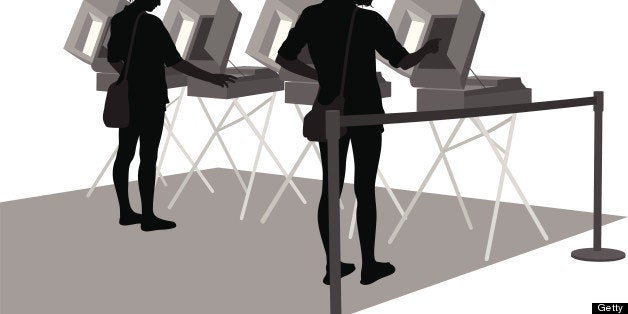
When the Supreme Court makes a major decision, it does much more than determine the law of the land; it sets a tone and demarcates moral boundaries, helping define who we are as a people. In Brown v. Board of Education, when the Court ringingly declared that "separate educational facilities are inherently unequal," it undermined both the legal and the moral foundations of segregation. Similarly, when the Court recently declared the Defense of Marriage Act (DOMA) unconstitutional, stating that DOMA's principal purpose is "to demean those persons who are in a same-sex marriage," it cast those who would deny equality to gays as agents of humiliation and degradation.
If Supreme Court decisions convey, as Frank Bruni recently argued, powerful symbolic and emotional messages, what then was the broader message transmitted by the Court's recent decision on voting rights? In declaring a key part of the Voting Rights Act of 1965 unconstitutional, Chief Justice Roberts, writing for the majority, repeatedly emphasized that "things have changed dramatically" over the past half century. Striking down a crucial provision that required nine states, most of them Southern, to obtain "preclearance" by the federal government before changing voting procedures, Roberts insisted that this provision failed to reflect "current conditions." By classifying states with a long history of discrimination as needing approval from the Department of Justice before changing voting procedures and failing to ground this classification in "current conditions," Congress had violated the constitutionally guaranteed rights of states to "equal dignity" and "sovereignty." Claiming that Congress, in renewing the Voting Rights Act in 2006, had behaved "as if nothing had changed," Roberts' message was clear: civil rights advocates were mired in the past, while America had "made great strides" towards eliminating racial discrimination.
The unmistakable subtext of the Court's decision on the Voting Rights Act was that America had moved so vigorously in its effort to advance racial equality that it was now in danger of "reverse discrimination," whether against victimized states such as Alabama or victimized white individuals. In communicating this message, the Court majority was at once expressing and reinforcing a viewpoint increasingly popular among white Americans: that state-sanctioned discrimination against whites had become a pressing problem. In a remarkable new study of racial attitudes by Michael I. Norton and Samuel R. Sommers, over half of whites -- 51 percent -- now believe that anti-white racism is a bigger problem than racism against blacks. In sharp contrast, well over 90 percent of whites acknowledge that in the 1950s there was more racism against blacks than whites. It is worth noting that this viewpoint embodies the same essential narrative as the Roberts opinion in the Voting Rights case.
Yet in one respect, Roberts' opinion is undeniably right: America in 2013 is not the America of 1965. Unlike 50 years ago, today there are no segregated water fountains, no anti-miscegenation laws, and no governors publicly declaring (as did Alabama's George Wallace) "segregation now, segregation tomorrow, segregation forever." These changes are real, and they are immensely significant. But they do not tell us where we are currently as a nation. Has discrimination against whites in fact become more powerful than discrimination against blacks? Or does discrimination against blacks remain a potent force in American life?
A wide array of social scientific studies has addressed these questions, illuminating the contemporary role of race in the United States. Here are some of the more revealing findings:
- Blacks are far less likely than similarly qualified whites to get job interviews and job offers. In a classic experimental audit study of applicants to entry-level jobs by Princeton sociologist Devah Pager, only 14 percent of blacks received callbacks compared to 34 percent of non-criminal whites. Strikingly, "even whites with criminal records received more favorable treatment (17 percent) than blacks without criminal records (14 percent)."
- Residential segregation by race remains a central feature of American life -- a long-standing pattern with important consequences because of the effects of place of residence on education and employment opportunities. Audits by the Department of Housing and Urban Development (HUD) in nearly 30 metropolitan areas revealed pervasive discrimination by race, with adverse treatment involving fewer opportunities to view units, less information about units, and (for those who are home buyers) less help with financing.
- Blacks receive systematically harsher treatment from the criminal justice system. Of men born between 1965 and 1969, Harvard sociologist Bruce Western found that 22.4 percent of black men had been incarcerated by 1999 compared to only 3.2 percent of white men. In part, this racial gap reflects differential police practices. In New York City in 2011, for example, 700,000 people were detained under the City's well-known practice of stop-and-frisk; almost 9 in 10 of these people were black or Hispanic.
- Differential treatment by race continues all the way through to the ultimate sanction of the criminal justice system: the death penalty. In a recent study of Harris county in Texas which includes the city of Houston and has carried out 116 executions in the modern-era (more than any entire state except Texas itself), the district attorney was more than three times as likely to advance the case to a death penalty trial for blacks compared to white defendants, and black defendants were more than twice as likely to be sentenced to death.
But what about voting rights themselves, the subject of the Supreme Court ruling in Shelby County, Alabama v. Holder? Availing itself of the opening provided by the Court's elimination of federal preclearance of changes in voting practices in the nine affected states, Texas Attorney General Greg Abbott announced on the very day of the ruling that the same voter ID law that had been rejected by a three-judge federal panel last summer would "take effect immediately." Since then, four states -- Alabama, Mississippi, South Carolina and Virginia -- have joined Texas in moving ahead with restrictive laws on voting rights. That these laws will have a disparate racial impact is not in dispute. And given the political dynamics leading up to the adoption of these laws, only the most naïve of observers could doubt that making it more difficult for minorities to vote was also their intent.
Yet the most powerful impact of the Supreme Court's decision on Voting Rights may, in the end, not be on the size of the minority vote; it is possible, after all, that the very attempt to restrict the precious and hard-earned right to cast a ballot may spark a counter-mobilization among minority voters, much as it did in last year's presidential election. Instead, its most profound -- and insidious -- effect may reside in the weight it lends to an emergent narrative that racism is no longer a serious problem and that the real threat to equal justice now is "reverse discrimination" against whites. If one of the primary, if implicit, functions of the Supreme Court is -- as it did so powerfully in Brown v. Board of Education -- to separate myth from reality and to give renewed meaning to our nation's commitment to "equal justice under law," then the Roberts Court has proved sadly unequal to this task.
